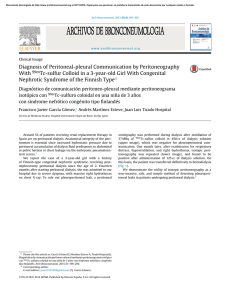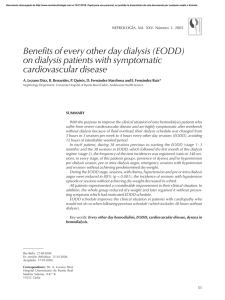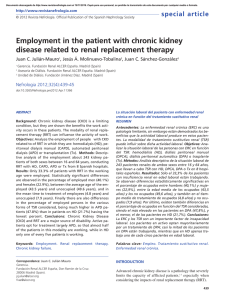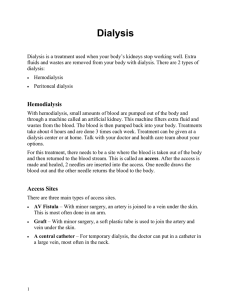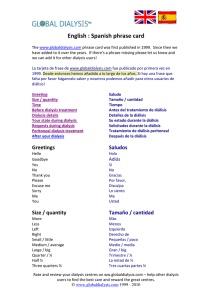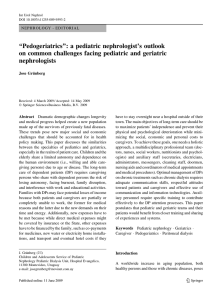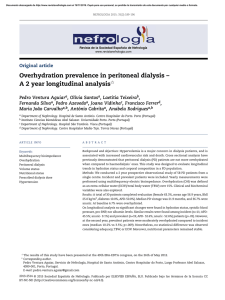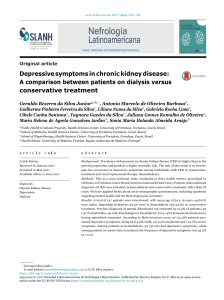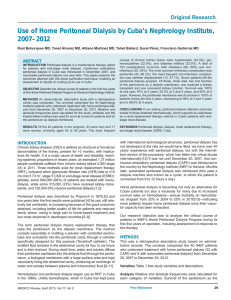Importance of ultrapure dialysis fluid on the response to treatment of
Anuncio
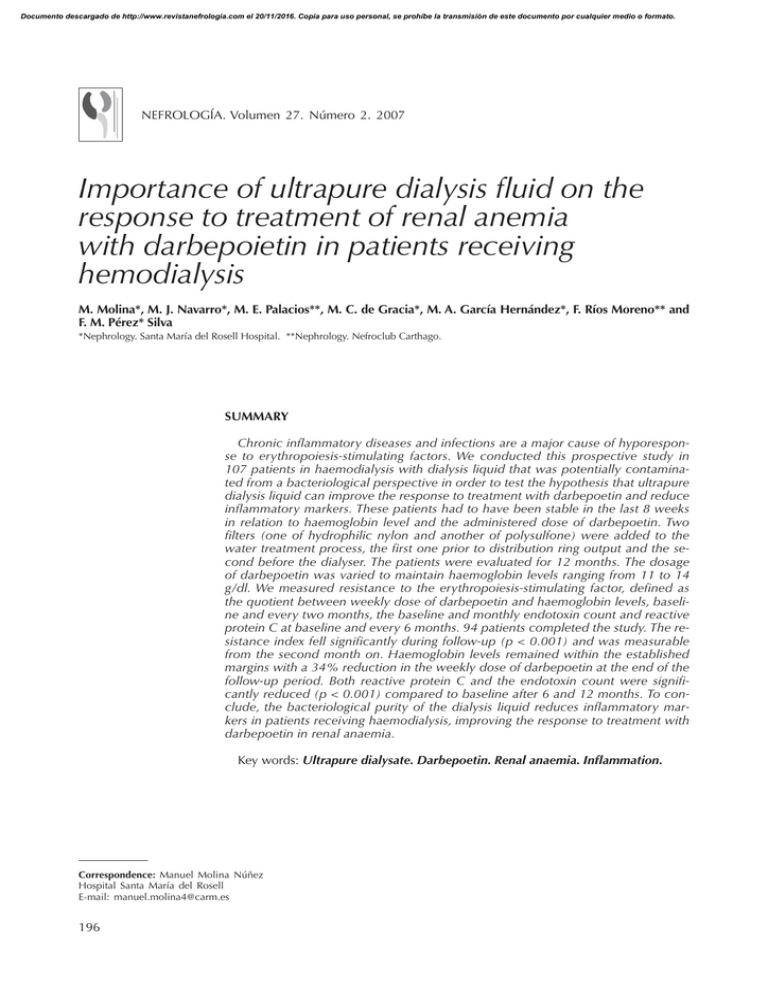
Documento descargado de http://www.revistanefrologia.com el 20/11/2016. Copia para uso personal, se prohíbe la transmisión de este documento por cualquier medio o formato. NEFROLOGÍA. Volumen 27. Número 2. 2007 Importance of ultrapure dialysis fluid on the response to treatment of renal anemia with darbepoietin in patients receiving hemodialysis M. Molina*, M. J. Navarro*, M. E. Palacios**, M. C. de Gracia*, M. A. García Hernández*, F. Ríos Moreno** and F. M. Pérez* Silva *Nephrology. Santa María del Rosell Hospital. **Nephrology. Nefroclub Carthago. SUMMARY Chronic inflammatory diseases and infections are a major cause of hyporesponse to erythropoiesis-stimulating factors. We conducted this prospective study in 107 patients in haemodialysis with dialysis liquid that was potentially contaminated from a bacteriological perspective in order to test the hypothesis that ultrapure dialysis liquid can improve the response to treatment with darbepoetin and reduce inflammatory markers. These patients had to have been stable in the last 8 weeks in relation to haemoglobin level and the administered dose of darbepoetin. Two filters (one of hydrophilic nylon and another of polysulfone) were added to the water treatment process, the first one prior to distribution ring output and the second before the dialyser. The patients were evaluated for 12 months. The dosage of darbepoetin was varied to maintain haemoglobin levels ranging from 11 to 14 g/dl. We measured resistance to the erythropoiesis-stimulating factor, defined as the quotient between weekly dose of darbepoetin and haemoglobin levels, baseline and every two months, the baseline and monthly endotoxin count and reactive protein C at baseline and every 6 months. 94 patients completed the study. The resistance index fell significantly during follow-up (p < 0.001) and was measurable from the second month on. Haemoglobin levels remained within the established margins with a 34% reduction in the weekly dose of darbepoetin at the end of the follow-up period. Both reactive protein C and the endotoxin count were significantly reduced (p < 0.001) compared to baseline after 6 and 12 months. To conclude, the bacteriological purity of the dialysis liquid reduces inflammatory markers in patients receiving haemodialysis, improving the response to treatment with darbepoetin in renal anaemia. Key words: Ultrapure dialysate. Darbepoetin. Renal anaemia. Inflammation. Correspondence: Manuel Molina Núñez Hospital Santa María del Rosell E-mail: [email protected] 196 Documento descargado de http://www.revistanefrologia.com el 20/11/2016. Copia para uso personal, se prohíbe la transmisión de este documento por cualquier medio o formato. ULTRAPURE DIALYSIS AND TREATMENT OF RENAL ANEMIA IMPORTANCIA DEL LÍQUIDO DE DIÁLISIS ULTRPURO EN LA RESPUESTA AL TRATAMIENTO DE LA ANEMIA RENAL CON DARBEPOETINA EN EL PACIENTE EN HEMODIÁLISIS RESUMEN Las enfermedades inflamatorias crónicas y las infecciones representan una causa mayor de hiporrespuesta a los factores estimuladores de la eritropoyesis. Para comprobar la hipótesis de que un líquido dializante ultrapuro puede mejorar la respuesta al tratamiento con darbepoetina y reducir los marcadores inflamatorios, condujimos este estudio prospectivo. Se reclutaron 107 pacientes en hemodiálisis con líquido dializante potencialmente contaminado desde el punto de vista bacteriológico. Para ello, debían estar estables en las últimas 8 semanas en cuanto a niveles de hemoglobina y dosis administrada de darbepoetina. Se añadieron dos filtros (uno de nylon hidrofílico y otro de polisulfona) al tratamiento de aguas, el primero previo a la salida al anillo de distribución y el segundo previo al dializador. Los pacientes se evaluaron durante 12 meses. Las variaciones de dosis de darbepoetina se realizaron para mantener niveles de hemoglobina entre 11 y 14 g/dl. Se determinaron índice de resistencia al factor estimulante de la eritropoyesis, definido como el cociente entre dosis semanal de darbepoetina y niveles de hemoglobina, basal y cada 2 meses, el recuento de endotoxinas basal y cada mes, y la proteína C reactiva basal y cada 6 meses. 94 pacientes completaron el estudio. El índice de resistencia se redujo de forma significativa durante todo el seguimiento (p < 0,001), objetivándose desde el segundo mes. Los niveles de hemoglobina se mantienen dentro de los márgenes establecidos con una reducción de la dosis de darbepoetina semanal de un 34% al final del periodo de seguimiento (p < 0,001). Tanto la proteína C reactiva como el recuento de endotoxinas se redujeron significativamente (p < 0,001) frente a las basales a los 6 y 12 meses. En conclusión, la pureza bacteriológica del líquido dializante disminuye los marcadores inflamatorios en el paciente en hemodiálisis, así como mejora la respuesta al tratamiento con darbepoetina en la anemia renal. Palabras clave: Líquido dializante ultrapuro. Darbepoetina. Marcadores inflamatorios. INTRODUCTION Plenty of evidences have been reported on quality of life improvement,1,2 cardiovascular protection,3,4 and decrease of the mortality and hospitalization relative risk5 in patients with renal anemia treated with erythropoiesis-stimulating factors (ESF). Thus, the European guidelines on treatment of renal anemia recommend a target hemoglobin > 11 g/dL in these patients.6 Darbepoietin alpha is a potent stimulator of erythropoiesis with the capability of correcting and maintaining hemoglobin levels within these recommendations, in patients both at pre-dialysis and during dialysis, and independently of the administration route and frequency as it has been reported by some authors and by our own group.7-10 The sensibility and response of renal anemia to therapy with ESF may be influenced by clinical factors,11 an some of them such as gender, age, time on dialysis, and comorbid factors such as hemoglobinopathies are not modifiable. By contrast, some others (inadequate iron loads, vitamin deficiencies, inadequate dialysis, and inappropriate dialysis fluid, among others) may be corrected by means of appropriate therapeutic intervention.6,11 Thus, infection and/or inflammation may interfere in the response to treatment with ESF. C reactive protein (CRP) is a useful marker to quantify the magnitude of the inflammatory process in dialysis patients, and it has recently been described by Barany et al.12, increased CRP levels behave as predictors of hyporesponse to therapy with erythropoietin. 197 Documento descargado de http://www.revistanefrologia.com el 20/11/2016. Copia para uso personal, se prohíbe la transmisión de este documento por cualquier medio o formato. M. MOLINA et al. Uremia may lead to inflammatory reactions, although dialysis may significantly contribute to the chronic inflammation syndrome that characterizes patients on hemodialysis. Monocytes activation and increased production of proinflammatory cytokines mat be caused by dialyzer-induced complement activation, by direct interaction between the cells ad the membrane, and by endotoxin-contaminated dialysis fluid.13 In this sense, an improvement in response to erythropoietin has been described in patients on chronic hemodialysis in whom ultrapure dialysis fluid is used.13,14 The present study was developed to assess the efficacy of hemodialysis using ultrapure dialyzing fluid on response to erythropoietin in patients on hemodialysis treated with darbepoietin, and to assess the progression of inflammatory markers. Selected patients, treated with potentially contaminated dialysis fluid from a bacteriological point of view, were dialyzed with ultrapure dialysis fluid. To achieve this, a hydrophilic nylon filter (capable of trapping particles bigger than 0.22 microns) was placed post-osmosis and a polysulfone filter was placed before the dialyzer (Diasafe, Fresenius Medical Care). The weekly or monthly doses of intravenous darbepoietin were adjusted to keep stable hemoglobin values ranging 11-14 g/dL.6 To maintain the iron status, 92.4% of the patients received intravenous sucrate iron at some point during the study. During the 12-month follow-up period, any modification of hemodialysis regimen in any patient was decided by a nephrologist according to clinical standards and the usual management of patients on chronic dialysis. METHODS Patients Study Parameters In order to be included in the study, patients were required to be older than 18 years, receiving hemodialysis therapy with conventional dialysis fluid for at least the previous 6 months, being on therapy with darbepoietin alpha for at least 12 weeks, with no important dose change (< 15%) within the last 8 weeks, as well as no changes in serum hemoglobin > 1 g/dL, having not received blood transfusions and adequate iron levels (serum ferritin * 150 µg/L y transferrin saturation * 20%). At the time of recruitment, no patient had acute or chronic infection, neoplasms, inflammatory disease, chronic blood losses, or surgical procedures. Throughout the study, hemoglobin (Hb, g/dL), ferritin (ng/mL), transferrin saturation index (TSI, %), and Kt/V (Dauguirdas 2d generation) were determined every 8 weeks. The primary efficacy end point is defined as the Erythropoiesis stimulating factor resistance index (ESFRI), determined as the weekly darbepoietin dose administered per kilogram of body weight and hemoglobin level (mcg/Kg/week/g/dL). High-sensitivity (particle-enhanced immunoturbidimetric method) C reactive protein was determined as the secondary end-point variable, at the beginning of the study and at 6 and 12 months of follow-up. Serum albumin (g/dL) is determined with the same frequency. Microbiological analysis of the dialysis fluid was done every month by standard agar tests (colony forming units (cfu) per milliliter). Monthly endotoxin count during the evaluation period was determined by chromogen kinetic analysis Pyrogent-LAL (endotoxin units, EU, per milliliter). The filtered dialysis fluid is considered ultrapure when it meets < 0.03 EU/mL and < 0.1 cfu/mL.15,16 Treatment Characteristics Hemodialysis sessions were done with the Fresenius Medical Care 4008S monitor. Session duration ranged 3.5-4.5 hours, three weekly sessions, with blood flow ranging 300-400 mL/min, and dialysis fluid flow 500-800 mL/min. Throughout the study, high-permeability biocompatible dialyzers were used (HF80 polysulfone Fresenius and FX60 helixone Fresenius). Statistical Analysis Study Design This was a prospective study developed at the Cartagena health care area. All recruited patients were evaluated for 8 weeks to check stability and, later on, after modifying water treatment, for one year. 198 Descriptive studies for quantitative variables are expressed as means, ranges, and standard deviations. Qualitative variables are summarized as percentages and simple means. Each study variable is checked for normal distribution (Kolmogorov-Smirnov test). Means comparison Documento descargado de http://www.revistanefrologia.com el 20/11/2016. Copia para uso personal, se prohíbe la transmisión de este documento por cualquier medio o formato. ULTRAPURE DIALYSIS AND TREATMENT OF RENAL ANEMIA for not normally distributed variables (ESFRI, darbepoietin dose, CRP, and endotoxin count) is performed by the non-parametric W Wilcoxon’s test for related samples, and the Student’s t test for related samples for normally distributed variables (Hb, ferritin, TSI, albumin and Kt/V). Clinical significance of the primary efficacy variable (ESFRI) is assessed by Friedman’s F. RESULTS Sample Analysis A total of 107 patients were recruited for the study, of which 94 completed the 12-month follow-up period. All data are referred to patients completing 52 weeks of follow-up. Demographic and baseline characteristics are summarized in Table I. Efficacy As shown in Table II, there were no significant differences with regards to ESFRI, weekly dose of darbepoietin and hemoglobin during the recruitment period (8 weeks prior versus baseline situation). Figure 1 shows the decrease in ESFRI throughout the 12 months of follow-up, with clinical significance (Friedman’s F, p < 0.001). At all cut-off points, the resistance index significantly decreased as compared to baseline (Table III). Mean hemoglobin levels were kept within the range throughout the follow-up period in both study arms, with a significant 34% decrease (p < 0.001) in weekly darbepoietin at the end of the follow-up period (0.64 ± 0.58 µg/kg and 0.42 ± 0.35 µg/kg, baseline and at 12 months, respectively), as shown in Figure 2. There were no significant differences as compared to baseline for ferritin, transferrin saturation index, and Kt/V at any of the cut-off points (Table III). We did not either observe changes in albumin levels (baseline 4.01 ± 0.22 g/dL) at 6 (3.99 ± 0.24 g/dL) and 12 months (3.98 ± 0.26 g/dL) of the study. About inflammatory parameters, there were significant decreases in C reactive protein (baseline 1.45 ± 2.67 mg/dL) at 6 (0.75 ± 0.81 mg/dL, p < 0.001) and 12 months (0.64 ± 0.77 mg/dL, p < 0.001). There was a significant decrease (p < 0.001) in endotoxin counts (0.0375 ± 0.0138 EU/mL at the beginning of the study, versus 0.0086 ± 0.0057 EU/mL and 0.0058 ± 0.0033 EU/mL at 6 and 12 months, respectively). Table I. Demographic and baseline characteristics Patients completing 52 weeks of follow-up Continuance on hemodialysis, months (range) Age, years* Gender, n (%) Males Females Cause of renal failure, n (%) Diabetes Glomerulonephritis Hypertension Hereditary Unknown Interstitial nephritis Dry weight, kg Hemoglobin level, g/dL* Darbepoietin weekly dose per kilogram of body weight, µg/kg* 94 62.1 ± 51.1 (12-290) 64.8 ± 14.6 54 (57.4%) 40 (42.6%) 22 (23.4) 21 (22.3) 17 (18.1) 14 (14.9) 12 (12.8) 8 (8.5%) 66.81 ± 12.62 12.35 ± 1.05 0.64 ± 0.58 Erythropoiesis stimulating factor resistance index, µg/kg/week/g/dl* Serum ferritin level, ng/mL* Transferrin saturation index, %* Kt/V* C reactive protein, mg/dL* Albumina, g/dL* 0.0533 ± 0.0468 325.73 ± 141.53 29.15 ± 8.69 1.44 ± 0.18 1.45 ± 2.67 4.01 ± 0.22 Statistical results are based on all patients completing 52 weeks of treatment. * Data are shown as mean ± standard deviation. Table II. Sample stability parameters Hemoglobin, g/dL Darbepoetin dose, µg/kg/week ESFRI, µg/kg/week/g/dl 8 previous weeks Baseline p 12.39 ± 0.97 12.35 ± 1.05 ns* 0.64 ± 0.57 0.64 ± 0.58 ns** 0.0516 ± 0.0498 0.0533 ± 0.0468 ns** *Student’s t test for related samples. **Wilcoxon’s W test for related samples. ESFRI, Erytrhopoiesis stimulating factor resistance index. DISCUSSION The benefits of correcting anemia in patients with chronic renal disease have been largely documented in medical literature, and previously discussed in the introduction.1-5. Administration of darbepoietin7-10 has been shown to be effective to reach and maintain the levels recommended by European guidelines,6 which describe the importance of bacteriological purity of the dialysis fluid and its relationship with the response to erythropoiesis stimulating agents. 199 Documento descargado de http://www.revistanefrologia.com el 20/11/2016. Copia para uso personal, se prohíbe la transmisión de este documento por cualquier medio o formato. p < 0.001* 0.0400 0.0200 16 1.4 14 1.2 12 1 10 0.8 8 0.6 6 0.4 4 0.2 2 0 0.0000 0 ESFRI 0.0533 2 4 6 0.0422 0.0418 8 10 0.0381 0.0336 12 0.0331 0.0347 months *Friedman’s F Fig. 1.—Progression of erythropoiesis stimulating factor resistance index. Hb, g/dl mcg/kg/week/g/dL ESFRI 0.0600 0 -0.2 0 The results from our prospective study in hemodialysis patients using ultrapure dialysis fluid for one year and compared with the same population treated with potentially contaminated fluid from a bacteriological point of view, show the significant decrease in the Erythropoiesis stimulating factor resistance index, in this case darbepoietin, requiring lower doses to reach higher hemoglobin levels. This decrease is significant from the second month onwards and is kept throughout the follow-up period. Our results are in agreement with those reported by others. Sitter et al.13 describe a 30.4% mean decrease in erythropoietin consumption at one year of followup in order to maintain the same hemoglobin levels, figures that are similar to those reported by Kleophas et al.17 (decrease of 37 ± 28 units per kilogram of body weight and week). These results are bilaterally verified by the crossing study by Hsu et al.14 where the switch of the conventional period to the period with ultrapure fluid accounted for a 15,2% decrease in erythropoietin dose and a 16,5% increase when the opposite switch occurs. One of the reasons argued by these authors may be the relationship with better use of iron stores, an issue that is not verified by our data since throughout the study both the ferritin and the transferrin saturation index remained unchanged. In the study by Rahmati et al.18 erythropoietin doses were not significantly modified with the use of ultrapure dialysis fluid, although hemoglobin levels were significantly increased at 6 and 9 months of fo- Dose, mcg/kg/week M. MOLINA et al. 2 4 6 Months 8 10 12 Fig. 2.—Progression of serum hemoglobin level (g/dL) and weekly darbepoietin dose (µg/kg/week). llow-up, which similarly implies an improvement in the resistance index. Other authors have communicated significant improvements in anemia with on-line hemodiafiltration technique19,20 that comprises reposition of ultrapure fluid among its basic principles. Of special interest are the results by Maduell et al.,19 since improvement occurs in spite of the fact that patients were receiving previous therapy with hemofiltration, suggesting the likely importance of fluid reposition in these results. In our series, the use of ultrapure dialysis fluid significantly reduces C reactive protein levels, as has been previously described by others.13,14,18,21. Although the mechanisms by which inflammation may affect erythropoiesis are complex, this reduction in CRP and in interleukin-6 levels13 after switching to ultrapure dialysis fluid and the improvement in the resistance to the erythropoiesis stimulating factor suggest the implication of proinflammatory cytokines in erythropoiesis suppression that, in some way, decreases the intracellular sensitivity to erythropoietin. Thus, Mcdougall et al. reported that interleukin-6 levels could be the best marker to monitor the hyporesponse to erythropoietin I dialysis patients.22 In many of these series,13,18,21 the reduction in inflammation markers was accompanied by a decrease in albumin le- Table III. Progression of ferritin, transferrin saturation index, and Kt/V Baseline Ferritin, ng/mL IST, % Kt/V 200 325.73 ± 141.53 29.15 ± 8.69 1.44 ± 0.18 2 months 337.36 ± 192.18 28.29 ± 7.94 1.43 ± 0.26 4 months 327.4 ± 197.43 27.83 ± 7.53 1.43 ± 0.20 6 months 311.27 ± 112.03 30.02 ± 7.62 1.43 ± 0.19 12 months 326.2 ± 106.64 28.15 ± 7.55 1.42 ± 0.17 Documento descargado de http://www.revistanefrologia.com el 20/11/2016. Copia para uso personal, se prohíbe la transmisión de este documento por cualquier medio o formato. ULTRAPURE DIALYSIS AND TREATMENT OF RENAL ANEMIA vels, a result not found in the series of Hsu et al.14 or in ours. To conclude, hemodialysis with bacteriologically not contaminated dialysis fluid produces a decrease in inflammatory markers improving the response to renal anemia therapy with darbepoietin. To assess the impact on hemodialysis patients’ morbidity and mortality further crossed studies with longer follow-up period are needed. REFERENCES 1. Keown PA: Quality of life in end-stage renal disease patients during recombinant erythropoietin therapy. The Canadian erythropoietin study. Contrib Nephrol 88: 81-86, 1991. 2. Valderrábano F: Quality of life benefits of early anaemia treatment. Nephrol Dial Transplant 15: 23-28, 2000. 3. Foley RN, Parfrey PS, Morgan J y cols.: Effects of hemoglobin levels in hemodialysis patients with asymptomatic cardiomyopathy. Kidney Int 58: 1325-1335, 2000. 4. McMahon LP, Mason K, Skinner SL y cols.: Effects of hemoglobin normalization on quality of life and cardiovascular parameters in end-stage renal failure. Nephrol Dial Transplant 15: 1425-1430, 2000. 5. Locatelli F, Pisoni RL, Combe C y cols.: Anaemia in five European countries and associated mobidity and mortality among haemidialysis patients: results from de Dialysis Outcomes and Practice Pattern Study (DOPPS). Nephrol Dial Transplant 19: 121-132, 2004. 6. Locatelli F, Aljama P, Barany P y cols.: Revised European Best Practice Guidelines for the Management of Anaemia in Patients with Chronic Renal Failure. Nephrol Dial Transplant 19 (Supl. 2): ii1-47, 2004. 7. Martínez Castelao A y cols.: Estudio multicéntrico de darbepoetin alfa en el tratamiento de la anemia secundaria a insuficiencia renal crónica en diálisis. Nefrología 23 (2): 114-124, 2003. 8. Locatelli F y cols.: Treatment of anaemia in dialysis patients with unit dosing of darbepoetin alfa al a reduced dose frecuency relative to recombinant human erythropoietin (r-HuEPO). Nephrol Dial Transplant 18: 362-369, 2003. 9. Molina M, García Hernández MA, Navarro MJ y cols.: Tratamiento de la anemia renal con administración una vez cada dos semanas de darbepoetina alfa en pacientes con insuficien- 10. 11. 12. 13. 14. 15. 16. 17. 18. 19. 20. 21. 22. cia renal crónica prediálisis previamente tratados con epoetina alfa. Nefrología XXIV (1): 44-49, 2004. Molina M, García Hernández MA, Navarro MJ y cols.: Estudio comparativo sobre el tratamiento de la anemia renal en el paciente en hemodiálisis: cambio de vía de administración de epoetina alfa frente a conversión a darbepoetina. Nefrología XXIV (6): 52-59, 2004. Richardson D: Clinical factors influencing sensitivity and response to epoetin. Nephrol Dial Transplant 17 (Supl. 1): 53-59, 2002. Barany P, Divino JC, Bergstrom J: High C-reactive protein is a strong predictor of resistance to erythropoietin in hemodialysis patients. Am J Kidney Dis 29: 565-568, 1997. Sitter T, Bergner A, Schiffl H: Dialysate related cytokine induction and response to recombinant human erythropoietin in hemodialysis patients. Nephrol Dial Transplant 15: 1207-1211, 2000. Hsu PY, Lin CL, Yu CC y cols.: Ultrapure dialysate improves iron utilization and erythropoietin response in chronic hemodialysis patients- A prospective cross-over study. J Nephrol 17: 693-700, 2004. Kessler M, Canaud M, Pedrini LA y cols.: The EBPG Expert Group on Hemodialysis. European Best Practice Guidelines for Hemodialysis (part 1). Section IV. Nephrol Dial Transplant 17 (Supl. 7): 45-62, 2002. Guías de Gestión de Calidad del líquido de diálisis (LD). Sociedad Española de Nefrología. http://www.senefro.org/modules/subsection/files/agua.pdf. Kleophas W, Haastert B, Backus G y cols.: Long-term experience with an ultrapure individual dialysis fluid with a batch type mechine. Nephrol Dial Transplant 13: 3118-3125, 1998. Rahmati MA, Homel O, Hoenich MA y cols.: The role of improved of water quality on inflammatory markers in patients undergoing regular dialysis. Int J Artif Organs 27: 723-727, 2004. Maduell F, Del Pozo C, García H y cols.: Change from conventional haemofiltration to on-line haemodiafiltration. Nephrol Dial Transplant 14: 1202-1207, 1999. Bonforte G, Gallo P, Zerbi S y cols.: Improvement of anemia in hemodialysis patients treated by hemodiafiltration with highvolume on.line orepared sustitution fluid. Blood Purif 20: 357363, 2002. Arizono K, Nomura K, Motoyama T y cols.: Use of ultrapure ddialysate in reduction of chronic inflammation during hemodialysis. Blood Purif 22 (Supl. 2): 26-29, 2004. McDougall IC, Allen DA, Tucker B y cols.: Serum interleukin-6 levels are a useful indicator of narrow suppression in patients with resistance to erythropoietin due to inflammatory disease. Am Soc Nephrol 4: 428A, 1993. 201

